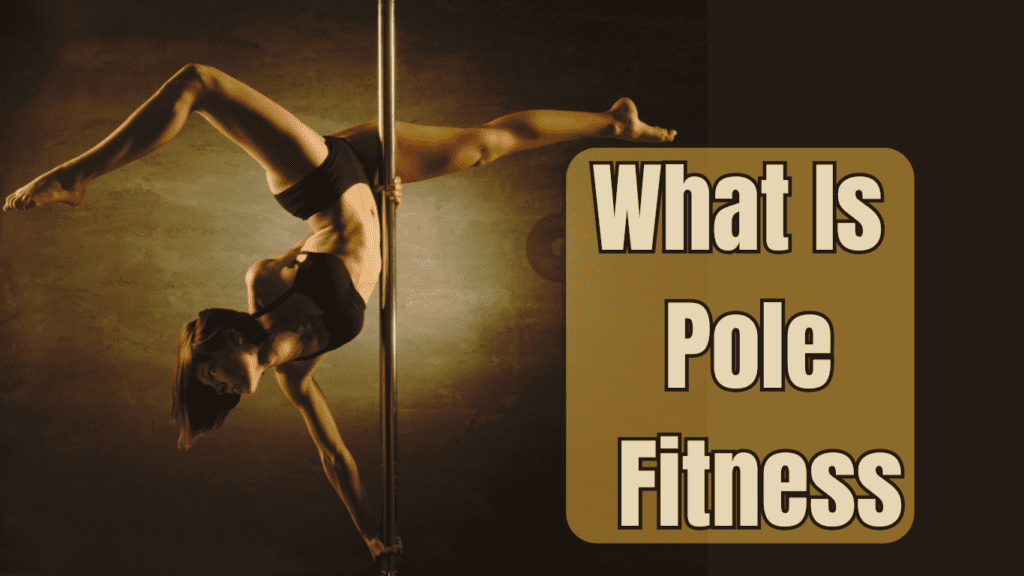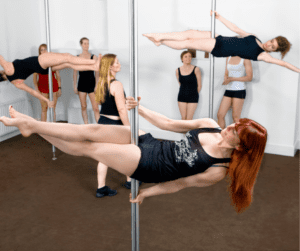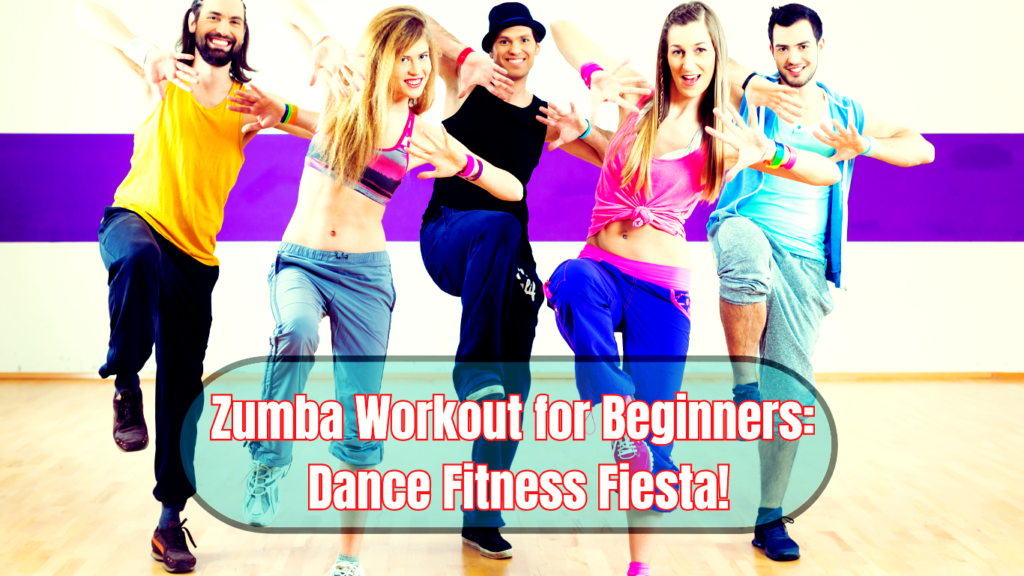Pole Fitness: A Journey Through History, Empowerment, and Global Popularity
In the realm of unconventional and exhilarating fitness routines, pole fitness stands tall as a unique and empowering form of exercise. This captivating blend of strength, flexibility, and artistry has gained immense popularity in recent years, attracting enthusiasts from various walks of life. To truly appreciate the essence of it, let’s embark on a journey through its intriguing history, exploring its origins, evolution, and the reasons behind its widespread appeal.
The roots of it can be traced back to ancient times, where it had a different, less recreational, and more cultural significance. In traditional Indian sports and Mallakhamb, a form of gymnastics originating in India, pole-like apparatuses were used for strength and agility training. Fast forward to the 12th century, when Chinese acrobats incorporated a vertical pole into their routines, showcasing impressive feats of balance and coordination.

However, the modern iteration of this pole fitness as we know it today emerged in the 20th century. The origins can be credited to the world of exotic dance and its gradual evolution into a fitness discipline. The transition from the strip club stage to fitness studios began in the 1980s and 1990s, marking the first steps toward pole fitness as a mainstream workout.
One pivotal figure in this transformation is Fawnia Mondey, often regarded as its pioneer. In the late 1990s, Mondey, a Canadian exotic dancer, recognized the potential of pole dancing as a form of exercise and established the first-ever school. Her vision laid the foundation for pole fitness to break free from its stereotypes, redefining it as a legitimate and empowering workout.
As the 21st century unfolded, pole fitness underwent a remarkable metamorphosis. It transcended its association with exotic dance and gained recognition as a comprehensive fitness regimen, fostering strength, flexibility, and cardiovascular endurance. Fitness enthusiasts and professional athletes alike embraced it, drawn to its ability to provide a full-body workout while promoting self-expression and confidence.
Subscribe And Get Our Free E-Book:Unlocking The Power Of Nutrition-Supplements, Substitutes, and Superfoods!
One of the driving factors behind the surge in popularity is its inclusive nature. It caters to individuals of all ages, body types, and fitness levels. The stigma surrounding pole dancing gradually dissolved as people began to appreciate its physical and mental benefits. Pole fitness classes became more accessible, making it a welcoming space for anyone seeking a fun and challenging way to stay fit.
What sets these fitness classes apart is its dynamic combination of strength training, dance, and acrobatics. Participants not only build muscle tone and increase flexibility but also develop a heightened sense of body awareness and coordination. The integration of dance elements adds a creative and expressive dimension, allowing individuals to tap into their artistic side while breaking a sweat.
The captivating allure of pole fitness lies in its ability to blend athleticism with artistic expression. Enthusiasts are drawn to the sense of empowerment that comes from mastering challenging moves and the freedom to express themselves through dance. The supportive community that has flourished around it also plays a significant role in its widespread appeal, fostering camaraderie among practitioners.
The history of pole fitness is a fascinating journey that has transformed a once-stigmatized activity into a widely embraced and celebrated form of exercise. From its ancient cultural roots to the modern fitness phenomenon, pole fitness has evolved, breaking barriers and captivating the hearts of fitness enthusiasts worldwide. Its popularity can be attributed to its inclusivity, empowering nature, and the perfect blend of physical and artistic elements. As we continue our exploration of this great type of fitness, we’ll delve deeper into its benefits, styles, and the thriving community that continues to shape its dynamic landscape.

Exploring the Nuances, Effectiveness, and Joyful Differences
It is crucial to understand the nuanced differences between pole fitness and pole dancing. While the terms are often used interchangeably, they carry distinct connotations, each offering a unique blend of physical activity, artistic expression, and fitness benefits.
Pole fitness encompasses a comprehensive workout routine that focuses on building strength, flexibility, and endurance. It incorporates elements of gymnastics, dance, and acrobatics, creating a holistic approach to physical well-being. The primary goal is to engage the entire body, promoting muscle toning, cardiovascular health, and enhanced flexibility.
On the other hand, pole dancing traditionally emerged as a form of entertainment in strip clubs. However, the modern evolution of pole dancing has seen it transcend its exotic roots to become a legitimate and empowering form of artistic expression. Pole dancing classes often emphasize choreography, fluidity of movement, and self-confidence through dance. While there’s an undeniable overlap with pole fitness, the emphasis on artistic expression distinguishes pole dancing from its fitness-centric counterpart.
Now, let’s dive into the effectiveness of pole fitness exercises. The dynamic movements and holds required engagement of various muscle groups, making it a surprisingly effective full-body workout. The combination of strength, flexibility, and endurance training contributes to improved fitness levels. Participants often find that these exercises not only enhance physical strength but also boosts self-esteem through the mastering of graceful and powerful movements.
The burning question for many fitness enthusiasts is whether this type of fitness can aid in weight loss. The answer is a resounding yes. Pole fitness is a calorie-burning activity that targets multiple muscle groups simultaneously, making it an efficient way to shed excess pounds. The cardio elements in pole fitness routines elevate the heart rate, facilitating fat loss while promoting overall fitness.
Building muscles is another aspect that shouldn’t be underestimated. The isometric holds, spins, and climbs involved in it contribute to muscle development, particularly in the arms, shoulders, and core. Contrary to the misconception that pole fitness only focuses on aesthetics, it’s a functional and strength-building exercise that fosters both physical and mental resilience.
Comparing pole fitness to traditional gym workouts sparks a healthy debate among fitness enthusiasts. While both have their merits, pole fitness offers a unique blend of strength training and artistic expression that distinguishes it from the conventional gym routine. Pole fitness engages the mind and body in a creative and dynamic way, making it an enjoyable alternative for those seeking variety in their fitness journey.
Moreover, the sense of community in its fitness classes creates a supportive environment, fostering a sense of camaraderie among participants. The inclusivity and encouragement found in pole fitness studios contribute to a positive and empowering experience, setting it apart from the potentially solitary nature of gym workouts.
In essence, pole fitness is not just about physical exercise; it is about self-discovery, confidence-building, and embracing a unique form of artistic expression. Whether you’re drawn to the athleticism of pole fitness or the creativity of pole dancing, both offer a path to holistic well-being that goes beyond the conventional boundaries of traditional workouts.
Pole Fitness Basics Video
Sculpting Strength and Grace
Commencing pole fitness journey can be both exhilarating and, for many, a tad intimidating. One common question that pops up is, just how challenging is this fitness class? Well, fear not, as the difficulty level varies, accommodating all fitness levels. These fitness classes are designed to be accessible for beginners, gradually building up in intensity as you progress.
For newcomers, the learning curve involves mastering fundamental moves, spins, and holds. Instructors break down each element, ensuring that participants feel confident before moving on to more advanced techniques. It’s all about pacing yourself, enjoying the process, and relishing the small victories along the way. So, whether you’re a fitness novice or a seasoned enthusiast, there’s a place for you on the pole.
Now, the burning question – how often should one attend pole fitness classes? The frequency largely depends on personal goals, fitness levels, and time commitments. Ideally, attending classes two to three times a week is a good starting point for beginners. This frequency allows for consistent practice, muscle engagement, and skill development. As you progress, you may find that your passion for pole fitness drives you to attend more frequently, further accelerating your advancement.
Results – we all want to see them, and the good news is that pole fitness delivers. The speed at which you’ll notice changes in your body can vary based on factors like individual fitness levels and consistency. Generally, participants start experiencing increased strength, improved flexibility, and enhanced body awareness within a few weeks of regular practice. The visible results, such as toned muscles and increased endurance, become more apparent over time with dedication and perseverance.
Now, let’s talk about the visual impact of the exercises on your physique. One of the remarkable aspects of pole fitness is its transformative effect on the body’s aesthetics. Engaging in regular pole fitness not only builds strength but also sculpts and tones muscles, particularly in the arms, shoulders, and core. The dynamic movements and holds contribute to a lean and defined physique, enhancing both strength and grace.
Is pole fitness a cardio workout or a strength-building exercise? The beauty lies in its versatility – it’s both. It seamlessly combines cardiovascular elements with strength training, creating a comprehensive workout that challenges your heart and muscles simultaneously. The fluidity of movements and transitions between poses elevate the heart rate, providing a cardio boost, while isometric holds and dynamic spins engage and build strength.
Beyond the physical gains, pole fitness offers a plethora of additional benefits. The sense of accomplishment derived from conquering challenging moves fosters confidence and self-esteem. The supportive community within these fitness classes creates a positive and inclusive environment, where individuals encourage and uplift one another. This camaraderie extends beyond the studio, creating lasting connections among enthusiasts.
Moreover, the artistic aspect of pole fitness allows for self-expression and creativity. It’s not just about following a routine; it’s about infusing your unique style into each move. This blend of physical and artistic expression contributes to enhanced mental well-being, stress relief, and a boost in overall happiness.
Pole fitness is not just a workout; it’s a transformative journey that caters to individuals of all fitness levels. Embrace the challenge, revel in the progress, and savor the holistic benefits that extend beyond the physical realm. Whether you’re seeking a full-body workout, a confidence boost, or a creative outlet, pole fitness invites you to explore your strength, grace, and individuality in a supportive and vibrant community.

Challenges and Choices between Pole Fitness and Popular Workouts
Diving into the realm of pole fitness, many newcomers are curious about the level of difficulty they might encounter in this class. It’s natural to wonder, especially if you’re comparing it to other popular fitness classes. Let’s unravel the intricacies and explore what makes pole fitness unique in terms of challenge, as well as delve into a comparison with the other 10 most popular fitness classes.
Fitness Experience Comparison Chart: Pole Fitness vs. Traditional Gym Workouts
| Feature | Pole Fitness Classes | Traditional Gym Workouts |
|---|---|---|
| Workout Style | Dynamic, combines strength training, dance, and acrobatics | Static, focuses on isolated muscle groups with weightlifting and cardio machines |
| Equipment Used | Pole apparatus, mats | Various machines (e.g., treadmills, weight benches, dumbbells) |
| Typical Duration | 60-90 minutes per class | 30-60 minutes per session |
| Social Aspect | Supportive community, often group classes with shared experiences | Individual-focused, may involve personal trainers or occasional group classes |
Firstly, the difficulty of a pole class is subjective and varies based on individual fitness levels, prior experiences, and personal expectations. Beginners often find the initial stages challenging as they acquaint themselves with basic moves, spins, and holds. The learning curve, however, is carefully designed to be gradual, allowing participants to build strength, flexibility, and confidence at their own pace. Instructors play a pivotal role in ensuring a supportive environment, guiding participants through each step and celebrating their progress.
Now, when we consider the vast landscape of fitness classes, it’s fascinating to explore how this fitness class stands out among the top 10 most popular choices. Each fitness class has its unique characteristics, targeting different aspects of physical well-being. Let’s briefly compare pole class with some of the most sought-after options:
- Yoga: While yoga emphasizes flexibility, balance, and mindfulness, the pole class adds an element of strength and dynamic movement. Pole fitness tends to be more cardio-intensive and incorporates acrobatic elements.
- CrossFit: CrossFit focuses on high-intensity, functional movements. Pole class, while also high-intensity, brings an artistic and dance element, fostering self-expression alongside physical challenges.
- Zumba: Zumba is a dance-based cardio workout, primarily focused on rhythmic movements. Pole fitness combines dance with strength training, offering a more comprehensive full-body workout.
- Spin (Cycling) Classes: Cycling classes are primarily cardiovascular workouts. Pole exercises, on the other hand, engages both cardio and strength aspects, incorporating spins, climbs, and holds.
- Pilates: Pilates emphasizes core strength, flexibility, and overall body toning. Pole fitness enhances core strength but also incorporates upper body and cardiovascular elements through spins and dynamic movements.
- Kickboxing: Kickboxing is a high-energy cardio workout with a focus on martial arts moves. Pole exercises, while cardio-intensive, integrates dance and acrobatics, providing a unique blend of strength and artistic expression.
- Bootcamp: Bootcamp classes are known for their intense, varied workouts. Pole fitness offers diversity through its combination of strength and dance, creating a dynamic and engaging experience.
- HIIT (High-Intensity Interval Training): HIIT focuses on short bursts of intense exercise. Pole fitness can incorporate HIIT elements but adds an artistic flair and continuous movement.
- Barre: Barre classes target small muscle groups for toning and sculpting. Pole fitness, while toning muscles, engages larger muscle groups through dynamic movements and holds.
- Aerial Silks: Aerial silks involve performing acrobatics on suspended fabric. While similar in the aerial aspect, pole fitness integrates dance, making it a more expressive and dynamic discipline.
When it comes to choosing a fitness class, it’s crucial to weigh the pros and cons. Pole fitness, with its unique blend of strength, flexibility, and artistic expression, offers a multifaceted approach to well-being. The plus side includes its engaging nature, building confidence, and fostering a supportive community. On the flip side, some may find the learning curve challenging initially.
Ultimately, the choice between pole fitness and other popular classes depends on personal preferences, fitness goals, and individual comfort levels. Consider what aspects resonate with you the most – whether it’s the strength-building, the dance element, or the community support. It’s advisable to try different classes to find the one that aligns with your interests


